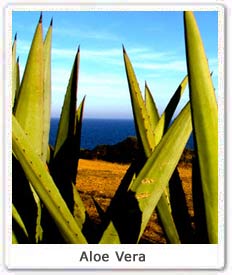| Kingdom : | Plantae |
| Division | Magnoliophyta |
| Class: | Liliopsida |
| Order : | Asparagales |
| Family : | Asphodelaceae |
| Genus : | Aloe |
| Species: | A .vera |
| Zoological name : | Aloe Vera |
| Found In : | Ranthambore Wildlife Sanctuary |
Other names : Cape aloe, Aloe curacao, Barbadoes aloe, Venezuela aloe, Indian alces, Ghirita, Lu hui, Star Cactus are the other names used for the Aloe Vera. It is also called miracle plant, Burn plant, medicine plant and first-aid-plant.
Description : Aloe Vera grows to a height of 12 to 16 inches. It has a fibrous root system. It does not have stems. It has thick freshly leaves with sharp points, which are up to 18 inches long and 2 inches wide at the base. Its leaves are even long and triangular in shape. The tissue in the center of the
 Aloe
leaf contains a gel which yields the aloe gel. Its leaves are rich in water
that is why it can survive for years. These leaves have spiky margins and
are blotched creams. It is the member of the Lilly family. The roots of the
pant are thick and fibrous. The fruit is the triangular capsule containing
numerous seeds.
Aloe
leaf contains a gel which yields the aloe gel. Its leaves are rich in water
that is why it can survive for years. These leaves have spiky margins and
are blotched creams. It is the member of the Lilly family. The roots of the
pant are thick and fibrous. The fruit is the triangular capsule containing
numerous seeds. Other species of Aloe Vera : There are more than 200 species of Aloe Vera. Aloe Barbadensis Miller, Aloe Saponaria, Aloe Chinensis, Aloe Variegata, Aloe Forex, Aloe Lalifolia and Curacao Aloe are some of the known species of Aloe Vera.
Location : Aloe Vera is cultivated throughout India. It is commonly found in Mumbai, Gujrat and South India. It mainly grows in the tropical and sub tropical areas. It grows well on sandy and well drained soil. It is widely grown in the Ranthambore National Park in India.
Cultivation methods : Aloe Vera plant is propagated through the seed. It prefers a well drained sandy soil in sunny location. Aloe Vera needs the temperature of above 40 degrees. They should be potted in the spring season and watered carefully until established. It grows in the arid climate. They should be watered regularly in the summers. But over watering can kill the plant. It also grows in partial shade. It reaches the maturity inn four years when the leaves are harvested.
Medicinal uses : Aloe Vera is the herbal plant, used to heal the burn marks. Aloe Vera cures the skin diseases. It can also be used to remove dandruff from the hair. Aloe Vera is taken internally for the stomach disorders. The leaves of Aloe Vera is used for the treatment of facial edema or swelling. Its fluid is beneficial in reducing the inflammation and pain. Aloe Vera is used in cosmetics and even in the food industry. Curacao aloe acts as laxative, which is used against constipation. The fresh juice of its leaf blades can be applied directly to the ulcers, burns, sunburns, and fungal infection. Organic Aloe Vera juice reduces acidity. It prevents from fungus, influenza virus, measles, and high fever.
Other uses : Aloe Vera is a very popular potted plant. It is grown in houses for the decoration. The leaf sap is used to make a soothing and healing moisturizing cream, which is good for the dry skin. It is used in the making of anti wrinkle cream. It is even used in the preparation of shampoos.
Cultural Importance :Aloe Vera has been mentioned several times in the sacred scriptures. It is believed to have been used for the preservation of the body of the Jesus Christ. It is called as the plant of immorality. It is also mentioned in the holy book of Bible. It has been used by the tribal people as a medicine for the century.






